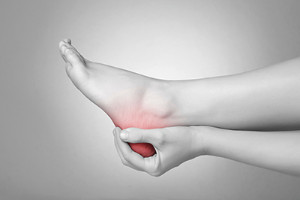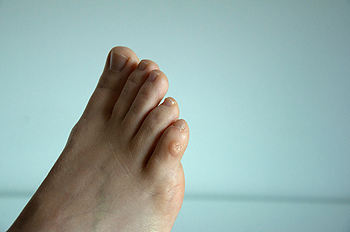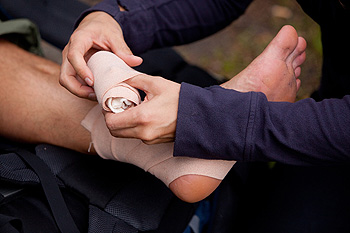January 2021
Arthritis Can Cause Pain in the Feet and Ankles
How Toenail Fungus May Be Treated
A fungal infection that affects the nail bed is referred to as toenail fungus. It affects many people worldwide, and may appear unsightly. The medical term for this condition as onychomycosis, and can cause the nails to become yellowed, thickened, and brittle. The fungi that causes this ailment lives and thrives in warm and moist environments. These environments include shower room floors, public swimming pools, and surrounding areas. Some patients find success in treating this disorder with oral or topical medications, or having laser surgery performed. If you are affected with toenail fungus, please confer with a podiatrist who can offer correct treatment options.
If left untreated, toenail fungus may spread to other toenails, skin, or even fingernails. If you suspect you have toenail fungus it is important to seek treatment right away. For more information about treatment, contact Dr. Scott Shrem of Garden State Foot & Ankle Center. Our doctor can provide the care you need to keep you pain-free and on your feet.
Symptoms
- Warped or oddly shaped nails
- Yellowish nails
- Loose/separated nail
- Buildup of bits and pieces of nail fragments under the nail
- Brittle, broken, thickened nail
Treatment
If self-care strategies and over-the-counter medications does not help your fungus, your podiatrist may give you a prescription drug instead. Even if you find relief from your toenail fungus symptoms, you may experience a repeat infection in the future.
Prevention
In order to prevent getting toenail fungus in the future, you should always make sure to wash your feet with soap and water. After washing, it is important to dry your feet thoroughly especially in between the toes. When trimming your toenails, be sure to trim straight across instead of in a rounded shape. It is crucial not to cover up discolored nails with nail polish because that will prevent your nail from being able to “breathe”.
In some cases, surgical procedure may be needed to remove the toenail fungus. Consult with your podiatrist about the best treatment options for your case of toenail fungus.
If you have any questions, please feel free to contact our office located in Hazlet, NJ . We offer the newest diagnostic and treatment technologies for all your foot care needs.
Plantar Fascia Injections
 Plantar fasciitis is an inflammation of the plantar fascia, the ligament that runs along the bottom of the foot connecting the heel bone to the toes. This condition can cause pain on the inside of the bottom of the heel, and it is often the result of overuse injuries from activities that put repetitive stress on the foot, such as running or jogging. Typical treatments for plantar fasciitis can include resting and icing the affected foot, wearing orthotic devices in the shoes, and taking anti-inflammatory drugs. In some cases, these treatments may be ineffective and other options can be explored. One other potential treatment for plantar fasciitis is an injection of a corticosteroid into the plantar fascia. This can reduce inflammation and relieve pain for a longer period of time than more conservative measures. If you are experiencing heel pain, it is suggested that you see a podiatrist for treatment.
Plantar fasciitis is an inflammation of the plantar fascia, the ligament that runs along the bottom of the foot connecting the heel bone to the toes. This condition can cause pain on the inside of the bottom of the heel, and it is often the result of overuse injuries from activities that put repetitive stress on the foot, such as running or jogging. Typical treatments for plantar fasciitis can include resting and icing the affected foot, wearing orthotic devices in the shoes, and taking anti-inflammatory drugs. In some cases, these treatments may be ineffective and other options can be explored. One other potential treatment for plantar fasciitis is an injection of a corticosteroid into the plantar fascia. This can reduce inflammation and relieve pain for a longer period of time than more conservative measures. If you are experiencing heel pain, it is suggested that you see a podiatrist for treatment.
Plantar fasciitis can be very painful and inconvenient. If you are experiencing heel pain or symptoms of plantar fasciitis, contact Dr. Scott Shrem from Garden State Foot & Ankle Center. Our doctor can provide the care you need to keep you pain-free and on your feet.
What Is Plantar Fasciitis?
Plantar fasciitis is the inflammation of the thick band of tissue that runs along the bottom of your foot, known as the plantar fascia, and causes mild to severe heel pain.
What Causes Plantar Fasciitis?
- Excessive running
- Non-supportive shoes
- Overpronation
- Repeated stretching and tearing of the plantar fascia
How Can It Be Treated?
- Conservative measures – anti-inflammatories, ice packs, stretching exercises, physical therapy, orthotic devices
- Shockwave therapy – sound waves are sent to the affected area to facilitate healing and are usually used for chronic cases of plantar fasciitis
- Surgery – usually only used as a last resort when all else fails. The plantar fascia can be surgically detached from the heel
While very treatable, plantar fasciitis is definitely not something that should be ignored. Especially in severe cases, speaking to your doctor right away is highly recommended to avoid complications and severe heel pain. Your podiatrist can work with you to provide the appropriate treatment options tailored to your condition.
If you have any questions please feel free to contact our office located in Hazlet, NJ . We offer the newest diagnostic and treatment technologies for all your foot and ankle needs.
What Causes Corns to Form?
 Corns are formed by a buildup of hardened and dead skin, normally around the top of the foot, side of the foot, or on the toes. Corns have a cone-shaped core that can press down on the nerve beneath it, leading to pain. The most common cause of corns is wearing poorly fitting shoes that produce excess friction when they rub against the foot. Already existing corns can become inflamed by friction as well. Activities like running and climbing can also lead to corns. The most common solution to treating corns is wearing properly fitted footwear. It is important to wear shoes with a wide toe box, and to avoid shoes that are too tight or too loose. If you have corns on your feet that are persistent or causing you discomfort, or if you are diabetic, it is highly recommended that you consult with your local podiatrist.
Corns are formed by a buildup of hardened and dead skin, normally around the top of the foot, side of the foot, or on the toes. Corns have a cone-shaped core that can press down on the nerve beneath it, leading to pain. The most common cause of corns is wearing poorly fitting shoes that produce excess friction when they rub against the foot. Already existing corns can become inflamed by friction as well. Activities like running and climbing can also lead to corns. The most common solution to treating corns is wearing properly fitted footwear. It is important to wear shoes with a wide toe box, and to avoid shoes that are too tight or too loose. If you have corns on your feet that are persistent or causing you discomfort, or if you are diabetic, it is highly recommended that you consult with your local podiatrist.
If you have any concerns regarding your feet and ankles, contact Dr. Scott Shrem of Garden State Foot & Ankle Center. Our doctor will treat your foot and ankle needs.
Corns: What Are They? and How Do You Get Rid of Them?
Corns can be described as areas of the skin that have thickened to the point of becoming painful or irritating. They are often layers and layers of the skin that have become dry and rough, and are normally smaller than calluses.
Ways to Prevent Corns
There are many ways to get rid of painful corns such as wearing:
- Well-fitting socks
- Comfortable shoes that are not tight around your foot
- Shoes that offer support
Treating Corns
Treatment of corns involves removing the dead skin that has built up in the specific area of the foot. Consult with Our doctor to determine the best treatment option for your case of corns.
If you have any questions please feel free to contact our office located in Hazlet, NJ . We offer the newest diagnostic and treatment technologies for all your foot and ankle needs.
What Is a High Ankle Sprain?
 High ankle sprains occur when the upper ligaments of the ankle are torn or damaged. While low ankle sprains are more common and usually occur from the ankle rolling inwards, high ankle sprains usually occur when the ankle rolls out and the deltoid ligaments on the inside of the ankle are torn. High ankle sprains can occur when the ankle bone or the fibula have already been fractured. If you are experiencing a high ankle sprain without a fracture, the foot will likely be able to bear weight, but the pain will be felt above the ankle between the tibia and fibula. If you believe that you have experienced a high ankle sprain, you will need to visit a podiatrist to rule out any broken bones or severe ligament damage. Upon diagnosis, a high ankle sprain can require 6-12 weeks for a full recovery and your podiatrist will provide various treatment options that are best for you.
High ankle sprains occur when the upper ligaments of the ankle are torn or damaged. While low ankle sprains are more common and usually occur from the ankle rolling inwards, high ankle sprains usually occur when the ankle rolls out and the deltoid ligaments on the inside of the ankle are torn. High ankle sprains can occur when the ankle bone or the fibula have already been fractured. If you are experiencing a high ankle sprain without a fracture, the foot will likely be able to bear weight, but the pain will be felt above the ankle between the tibia and fibula. If you believe that you have experienced a high ankle sprain, you will need to visit a podiatrist to rule out any broken bones or severe ligament damage. Upon diagnosis, a high ankle sprain can require 6-12 weeks for a full recovery and your podiatrist will provide various treatment options that are best for you.
Although ankle sprains are common, they aren’t always minor injuries. If you need your ankle injury looked at, contact Dr. Scott Shrem from Garden State Foot & Ankle Center. Our doctor can provide the care you need to keep you pain-free and on your feet.
How Does an Ankle Sprain Occur?
Ankle sprains are the result of a tear in the ligaments within the ankle. These injuries may happen when you make a rapid shifting movement while your foot is planted. A less common way to sprain your ankle is when your ankle rolls inward while your foot turns outward.
What Are the Symptoms?
- Pain at the sight of the tear
- Bruising/Swelling
- Ankle area is tender to touch
- In severe cases, may hear/feel something tear
- Skin discoloration
Preventing a Sprain
- Wearing appropriate shoes for the occasion
- Stretching before exercises and sports
- Knowing your limits
Treatment of a Sprain
In many cases, the RICE method (Rest, Ice, Compression, and Elevate) is used to treat ankle sprains. However, you should see a podiatrist to see which treatment option would work best with your injury. In severe cases, surgery may be required.
It is important to ask your doctor about rehab options after you receive treatment for your injury. Stretching, strength training, and balance exercises may help the ankle heal while also preventing further injury.
If you have any questions, please feel free to contact our office located in Hazlet, NJ . We offer the newest diagnostic and treatment technologies for all your foot care needs.
Blog Archives
- April 2025
- March 2025
- February 2025
- January 2025
- December 2024
- November 2024
- October 2024
- September 2024
- August 2024
- July 2024
- June 2024
- May 2024
- April 2024
- March 2024
- February 2024
- January 2024
- December 2023
- November 2023
- October 2023
- September 2023
- August 2023
- July 2023
- June 2023
- May 2023
- April 2023
- March 2023
- February 2023
- January 2023
- December 2022
- November 2022
- October 2022
- September 2022
- August 2022
- July 2022
- June 2022
- May 2022
- April 2022
- March 2022
- February 2022
- January 2022
- December 2021
- November 2021
- October 2021
- September 2021
- August 2021
- July 2021
- June 2021
- May 2021
- April 2021
- March 2021
- February 2021
- January 2021
- December 2020
- November 2020
- October 2020
- September 2020
- August 2020
- July 2020
- June 2020
- May 2020
- April 2020
- March 2020
- February 2020
- January 2020
- December 2019
- November 2019
- October 2019
- September 2019
- August 2019
- July 2019
- June 2019
- May 2019
- April 2019
- March 2019
- February 2019
- January 2019
- December 2018
- November 2018
- October 2018
- September 2018
- August 2018
- July 2018
- June 2018
- May 2018
- April 2018
- March 2018










